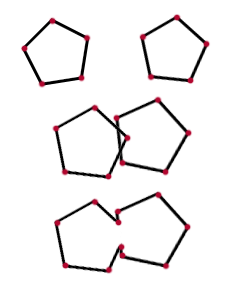Introduction
Particle growth and combination due to a difference in the free energy density between the particles and their environment is a common occurence on the nano/microstructural level. Being able to accurately model the intersection of multiple particles is a valuable tool and is the goal of our project. By forming two particles using nodes which can be randomly generated or assigned by the user and defining the paramters of the scenario in terms of constants such as the free energy densities and the mobility, a reasonably accurate depiction of growth of the particles before intersection can be made. As the particles intersect, the specific points of intersection are calculated and a new particle is formed using these nodes. After the intersection, the new, larger particle undergoes growth based on the parameters assigned at the start of the simulation. This is achieved through the finite element method and has been programmed in Matlab.

Possible Applications
The possible applications for code which models the growth and combination of multiple particles are widely varied. In general, the code's parameters could be modified to model any number of scenarios, although in the current code, the two particles must possess the same properties, as they are modeled using the same set of parameters. One possibility for our code involves the modeling of the sintering of particles, which consists of multiple particles being brought together under higher temperatures and increasing the desnity of the solid containing the particles by removing porosity through the combination of individual particles or grains. A possible use in the pharmaceutical industry would be to model the combination of particles used in the formulation of drugs even down to an atomic level, although additional considerations regarding the environment and the particle growth or lack thereof would have to be taken into account.
